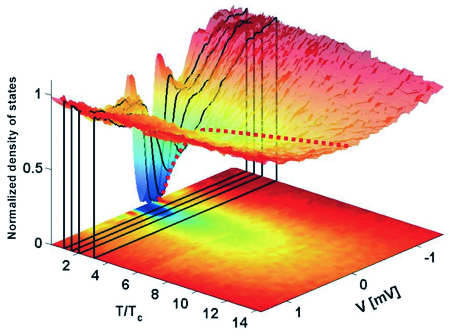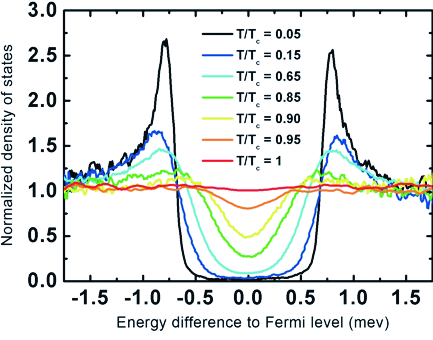The existence of a gap in the density of electronic states and its disappearance at the transition temperature T
c (see Figure 1) has been widely confirmed in experiments performed on numerous superconductors until the discovery of high critical temperature superconductors. In these so-called HTC materials, a large depression in the density of states is still observed above T
c, up to a temperature T* of the order of room temperature. This anomaly is coined pseudo-gap.
 Figure 1: Temperature dependence of the tunnelling density of states in a thin film of disordered TiN.
Figure 1: Temperature dependence of the tunnelling density of states in a thin film of disordered TiN.
Unlike bulk TiN, a large pseudo-gap is observed above Tc.Arguments about the pseudo-gap For more than 20 years physicists have been convinced that the key to understanding HTCs lies behind this pseudo-gap. Two opinions clash over this issue. One opinion claims that the pseudo-gap is a precursor state of superconductivity, in which electrons start to dynamically pair without forming a superfluid state. This model is backed by the observation that the superconducting gap below T
c turns smoothly into the pseudo-gap above T
c. Conversely, the other opinion states that the pseudo-gap competes with superconductivity and that it is the signature of a hidden order that remains to be discovered. This claim is based on the fact that by under-doping HTC materials, their resistivity increases, leading to a vanishingly small T
c but a higher T*. This situation suggests probing the density of states of conventional superconductors that are highly disordered, and therefore highly resistive, in the normal state.
Highly disordered TiN films to decide of the winner We measure the local density of electronic states through the conductance of the tunnel junction formed between a Scanning Tunnelling Microscope tip and the sample surface. If the sample is superconducting, we access its gap and possibly the thermal dependence of this gap. We have measured three 5 nm-thick TiN films which differ by their degrees of disorder. Unlike bulk TiN whose gap closes at T
c (see inset), these films exhibit a pseudo-gap that persists up to 14 T
c (see Figure 1). This is the first observation of a pseudo-gap in a conventional superconductor, and no hidden order can be reasonably invoked to explain it. The challenge consists in proving that we are dealing with superconducting fluctuations and not another physical phenomenon, such as dynamical Coulomb blockade. With this purpose in mind, let us plot the evolution of the density of states at the Fermi level as a function of the logarithm of the reduced temperature ε = ln(T/T
c). A linear behaviour as a function of ln(ε) is a signature of the presence of Cooper pairs above T
c , according to a theory which accounts for the order parameter fluctuations close to T
c. We have checked this behaviour for the three films investigated, as shown in Figure 2. For each of them, T
c was independently determined through resistivity measurements. If another value of Tc is arbitrarily chosen, the linear behaviour in Figure 2 is immediately lost: this is a dramatic illustration of the validity of this experimental signature.
The end of a mystery The dynamical Cooper pairing above T
c is a general phenomenon in superconducting transitions. However, it is often restricted to a temperature range which is so narrow that it is experimentally out of reach. In our case, the fluctuations are enhanced by the strong disorder and the closeness to the superconducting-insulating transition. Does it mean the end of the HTC mystery? This is not certain, because the order parameter symmetry of these superconductors is different, and things become more complicated.
Superconductivity and density of states
When a superconducting state sets in, the electrons form pairs (the so-called Cooper pairs) which are able to carry superfluid current. The onset of these pairs decreases the number of available states for single electrons, opening a gap in the normal electron density of state. This gap, which appears at the Fermi level, is about 2Δ wide,
i.e., on the order of 1 milli-electronvolt for usual superconductors having a superconducting transition temperature of a few kelvins. The states that disappear are transferred to the edge of the forbidden region, and so-called coherence peaks appear in the density of state at +-Δ on each side of the Fermi energy. The amplitude Δ is at maximum at T = 0, decreases when the temperature increases, and vanishes precisely at T
c in bulk materials. Above T
c, the metal is normal with a constant density of states.